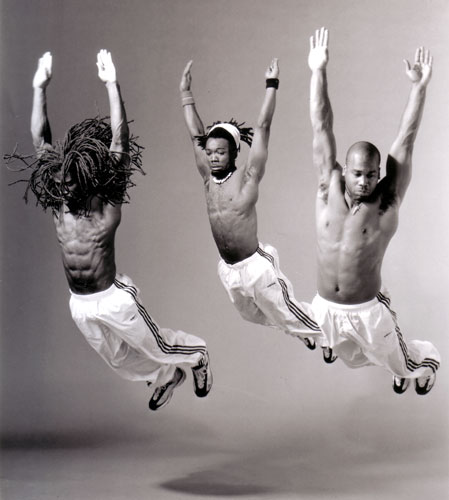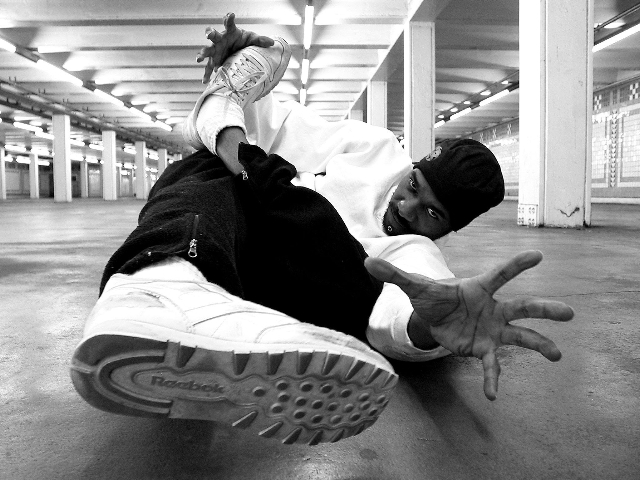Anya Porter: Breakti Founder, Movement/Wellness Specialist
Anya Porter’s passion for dance, yoga and overall spiritual & physical wellness led her to found Breakti, an ongoing workshop in NYC most simply described as a fusion of Breakin’ and yoga.
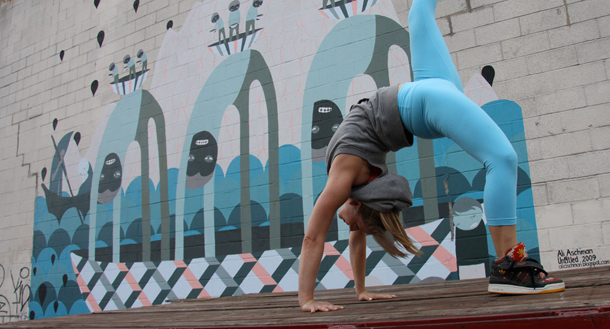
I knew Anya Porter for many years as this fly girl that I would see cutting up the dancefloor at parties, usually to a backdrop of Hip Hop or blistering Afro-Latin rhythms. Eventually we became friends and I discovered that in addition to her love of music and dance she is also a highly-regarded yoga instructor. Recently I connected with her to discuss these passions and how they converge in her burgeoning Breakti movement.
How would you describe your work & mission?
I guess I’ll start with Breakti and then talk about Yoga in general:
With Breakti my mission has always been to create connections between cultures and experiences. In my experience with dancing, specifically with street dance, there is an energy to it that I find can translate to the energy I feel after I take a yoga class—call it bliss, call it ecstasy, people call it all kinds of different things…in tribal cultures, in Africa, they’ll dance for hours & hours and go into a trance, it’s a way of connecting with the divine.
I feel that same way when I’m out in a club dancing for five hours straight….it’s not drug-induced, it’s something very different. There’s a touching of that same concept if I take a really good yoga class or if I have a really amazing practice.
That’s the highest mission I have, to connect people to their highest self, but that’s not something I talk about all the time in class as I think that can alienate people a little bit.
People get really serious about yoga, which I understand why they do, but I think that sometimes they forget that it’s a celebration.
On a more superficial, basic level, I’m trying to connect the physiology of the two forms. So, in yoga there are arm balances, you’re on your hands a lot and there’s a lot of exploration of bearing weight on different body parts, and it’s the same thing with Breakin’. Different styles of dance have a different feel, i.e. House, Hip Hop, but my goal on that level is to create connections between the two physical forms so that people can begin to understand, “Oh, I can approach this pose this way, or I can approach it this way.” But it’s kind of the same shape, and from those two different perspectives I hope that people get more comfortable, even if they’re not going to walk away a breaker (I’m not expecting anyone to do that), that they get more comfortable with their physical body and their yoga practice.
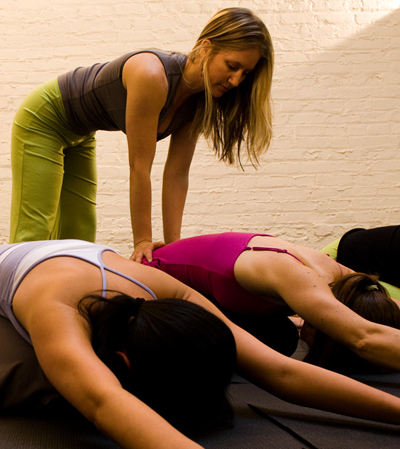 Also, if they’re not a yoga practitioner, they get a taste of that and they understand that there can be an element of fun & joyful exuberance that can happen in your practice. People get really serious about yoga, which I understand why they do, but I think that sometimes they forget that it’s a celebration. I feel like bringing those two genres together makes it feel more like a celebration.
Also, if they’re not a yoga practitioner, they get a taste of that and they understand that there can be an element of fun & joyful exuberance that can happen in your practice. People get really serious about yoga, which I understand why they do, but I think that sometimes they forget that it’s a celebration. I feel like bringing those two genres together makes it feel more like a celebration.
Those two things are very different, the connection of body, and the connection of the divine, but they’re two very real missions that I have.
With the straight-up yoga classes, it’s the same thing but it’s a little more subtle, because I’m mostly dealing with yoga practice, but part of what I do is I bring in different genres of music, try to get people to experience music in different ways and use it as an inspiration for the practice.
The way that I sequence the classes in yoga are often around a higher, more spiritual theme, like compassion, or how to take a moment every few hours to remember how to take a breath…things that are more down to earth but have sort of a higher purpose, and I thread the class around that, and again I try not to put too much emphasis on that, I put little morsels but I don’t want to alienate people with what I believe is spirituality, because that’s a really personal thing.
On a physical level my classes are sequenced in a way that tends to have a more dance-like quality—it’s very fluid, the poses move from pose to pose pretty seamlessly, but then in all of that there is a connection, at a very basic level, to safety in the body, through proper alignment and use of breath.
Your practice encompasses a lot of different studies & cultures, (dance to yoga, to meditation techniques)—can you talk a bit about your background, your early influences and how these coalesced into what you’re doing now?
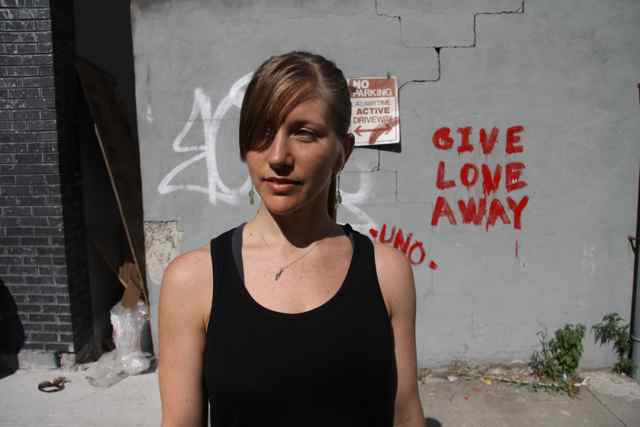 I spent my whole life dancing. Early on I had to do ballet—I couldn’t stand it! I didn’t like the classical lines and what I felt was the rigidness of ballet. All I wanted to do was jazz class—I loved the music, I loved the movement, it was much more edgy…. I feel like that was the first key to myself that that was where I was heading, that I wasn’t meant to be a ballet dancer, my body wasn’t designed for it and it’s a very specific form, and the body type that goes along with that is very specific…when you hit puberty and you become aware that you’re not going to be 5’9” and 105 lbs, you know.
I spent my whole life dancing. Early on I had to do ballet—I couldn’t stand it! I didn’t like the classical lines and what I felt was the rigidness of ballet. All I wanted to do was jazz class—I loved the music, I loved the movement, it was much more edgy…. I feel like that was the first key to myself that that was where I was heading, that I wasn’t meant to be a ballet dancer, my body wasn’t designed for it and it’s a very specific form, and the body type that goes along with that is very specific…when you hit puberty and you become aware that you’re not going to be 5’9” and 105 lbs, you know.
So over time all I wanted to do was jazz, but people kept saying “no, you’ve got to keep doing ballet,” to the point where I stopped dancing for a while in high school and was a cheerleader. This was in Columbus, Ohio. We still did a lot of dance—Hip Hop, Pop and stuff I really enjoyed moving to. Our cheerleading was really serious, we went to nationals and did that whole thing. To this day it’s a giggle, because people have a very specific idea of what cheerleading is, but I think what we did was different than the conception that most people have.
Anyway, when I got to college, I was going to be a Plant Biology major, and I started taking dance classes again and decided that I was going to minor….then I decided to double-major, and did that for 3 years. I was studying Modern, which I enjoyed somewhat but still felt very close to Ballet….I was yearning for something more Hip Hop-related, I did a Jazz dance program in Colorado, and also got more into the Rave scene, and also the burgeoning Hip Hop scene in Columbus….RJD2, Blueprint and all those guys, they were all coming out of Columbus and that was getting big.
So on one side I was learning about electronic music and House , and on the other I was really, really into Hip Hop. I would go to the clubs or a Hip Hop night and there would be breakers there. I was like, “I have GOT to learn how to do this,” so I started approaching people and learning here & there. And then I found a company in Philadelphia that was doing Hip Hop onstage, in what you could call a high arts theatre, and I started going for two weeks every summer for three years to study. The company’s called Rennie Harris Puremovement and they’re still around.
As soon as I graduated from school I moved to Philly, I didn’t know anyone, I just kind of knew the dancers that I learned from, I was totally intimidated & shy, but I also knew what I wanted to do. I would show up at clubs and shyly ask people to teach me things. In retrospect I kind of wish that I hadn’t been so shy, but that’s just how I was. I was going to classes, I was flat broke, I was waiting tables. It was definitely a starving artist life. But I was really inspired!
As I spent more time there and got to know more people, I became really inspired by Raphael Xavier, who I still consider my main teacher. He started a company called Olive Dance Theater, which is still in existence, although he’s no longer the Creative Director. He was doing something really different with Breakin’, it was really deconstructed and so much more than one of those productions where you go and it feels inauthentic, like a music video, with all the dancers smiling & in synch, feeling almost like a minstrel show—they’re taking this ethnic form, and putting it on stage and making it accessible by putting these smiley faces on everyone and putting them in Adidas sweatsuits because that’s what people associate with Breakin’.
Xavier was doing something really different, he was creating costumes and amazing themes, and adding text and cool music, it was really unique. That’s where I got really inspired.To make a long story short, I injured my back and had to stop dancing. I got to the point where I was broke, I was waiting tables, I wasn’t dancing, and I was miserable. I started taking yoga and I realized that since I didn’t have health insurance I had to figure out a way to heal myself without paying thousands of dollars for it. So I moved back home, got my yoga certification, saved money.
During this whole time I did continue to do some dance-related work, I created some modern choreography that included some Breakin’, and got really into House music.
I moved to New York and went the whole yoga teacher route for a while, but I really missed dance and the community of being at Hip Hop shows, or being out and hearing House, dancing for hours. So I started trying to figure out ways that I could bring that together.
So I guess those were the main influences over the last 30 years of my life! (laughs)
In your classes you’re making connections between all these different types of studies—street dance, yoga, meditation…I find that dynamic really intriguing. What was the process by which you combined these to form a cohesive program?
That’s a good question, because I’m still in that process, it’s a constant refinement. I never thought that I would end up putting all this together, it all just started with me just wanting to have a DJ in my classroom! (laughs)
I’d have Ben [DJ Scribe] playing music in the classroom, and I would say, “this is my background, I just want to show you how this freeze is like this arm balance.” And people really responded to it so I started adding more and more and it morphed that way over time. I started to figure out how to create a class where it flowed from one to the next, and I think it’s still in process. A lot of it is just me playing around in the studio, figuring out “How can I do this yoga move and show how it relates to this Breakin’ connection? How can I incorporate the fluidity of House movement? How can I connect the history, the roots and the culture to the yoga so that people are getting inspired by this?”
I feel like that process is going to be happening as long as this class exists. There will always be refinement. On a physical level it just boils down to me practicing and playing, and figuring out how things connect, and then on a more programming/how-the-class-is-laid-out level, I feel like there’s still a lot of room to grow. It’s really been about trial and error, I’ve been working on how to make the class progressive. When I did the last series I talked about the history of Breakin’, one week I talked about the history of house, and got a little bit into Vogueing and Waacking. We did some early ‘90’s Hip Hop, which was fun because a lot of people know & love that music.
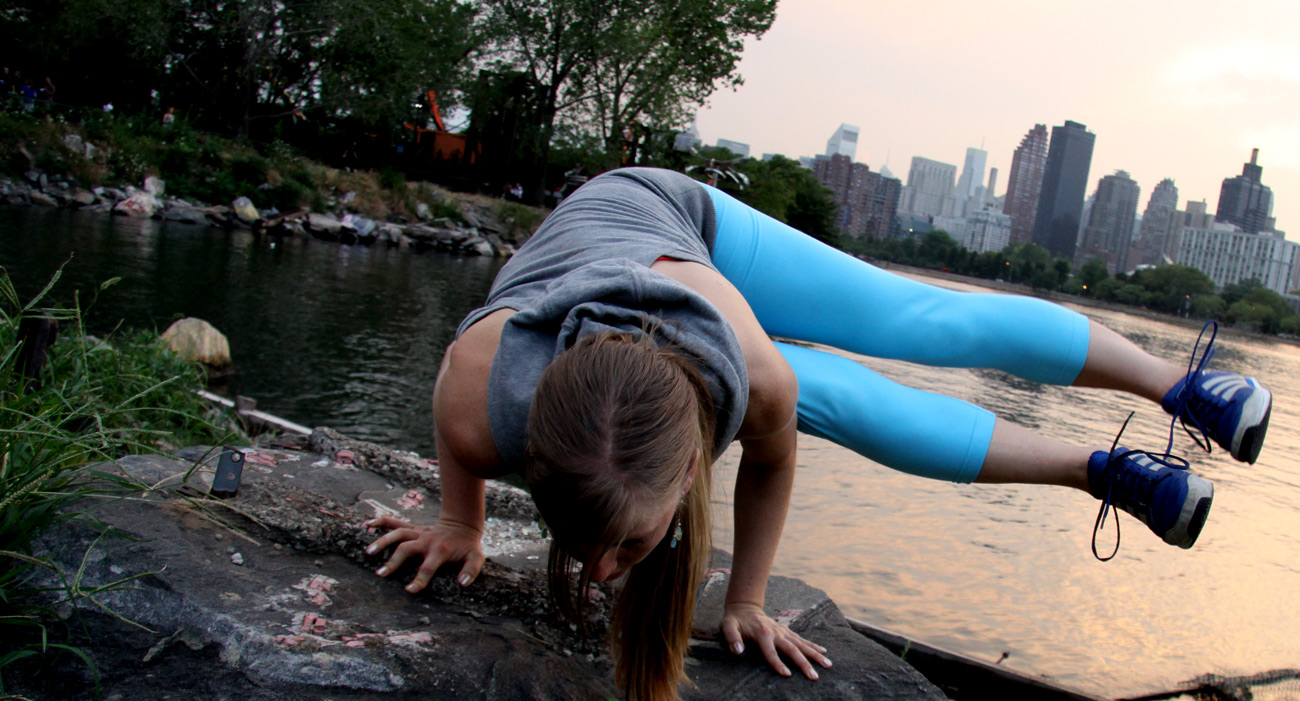
You & I tend to run in crowds that are very multicultural, very multi-ethnic. Even so, do you ever have anyone say, “Who is this little blonde white girl, what the f-ck does she know about Hip Hop?”
Totally! It’s always been that way.
How do you deal with that when it happens?
I feel like my yoga practice has made me more able to deal with that…I used to take it really hard, it was difficult to face that animosity and misunderstanding. I feel like at this point it’s par for the course, it comes with the territory.
Now that I have this other practice it’s still painful when people assume things about me or make judgements because of what I look like or where I’m from, but at the end of the day I feel a lot more safe and comfortable in myself than I used to.
And that’s one of the beauties of the yoga practice, it brings you closer to yourself. When that stuff comes up, it’s not that big of a deal.
(Pauses) One thing I didn’t mention earlier was that when I first moved here there was a good 1-2 years where I wasn’t dancing, but I was doing so much yoga. I would find that when I went to the dancefloor at a club, even though I hadn’t been taking classes and hadn’t really been in “the scene,” that my dancing was so on point that it had never been before. I felt like my relationship with the music was different, my relationship with breath & my body, and I still feel that way. My dancing has evolved tremendously since I moved to NY…and yes, part of that is seeing & hearing all sorts of music, and dancing for sure, but my main focus has not been dance…and yet it’s been right alongside me this whole time, evolving as I evolve my yoga practice, which….I think is cool!
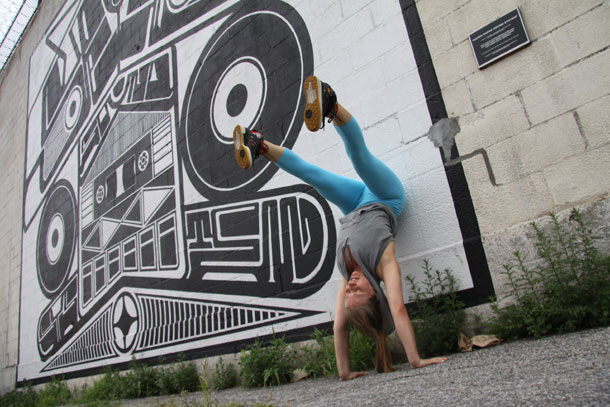
Going back to Breakti, Hip Hop is known for its competitive, no kid gloves culture, i.e., “If you don’t have style then hang it up, sit your ass down,” etc.—when you’re teaching the class, how do you reconcile this competitive aspect with the more forgiving, accepting aspects of yoga & meditative practices?
Well, even as a music listener, how do I reconcile my yoga practice with listening to Dr. Dre, (laughter) you know? I love both things. I think it’s really about acceptance that whatever these artists are coming to the table with, that’s their process.
This is part of our culture as Americans. This is what we have. How can we take these two things and try & create connections or pathways or bridges between them so that we can start to understand each other better.
I’m not condoning violence or sexism or any of that, but it is a part of the culture in many ways, and I think that part of being a yoga practitioner is saying “it’s all divine.” In yoga philosophy, from a non-dual perspective, they say that everything, even the darkness is divine, even “evil,” or death, all of this is part of the divine process. There are certainly some schools of thought that would say, “No way, this is not Ok to combine these different things,” but when I started to understand that perspective it helped me reconcile it for myself…
In a classroom setting I would never go that deep, to talk about that, but I think that just playing a song or track that has bad words or has some questionable content is simply saying that it’s accepted in that room, because I play it there can be a dialogue about it, at the end of the day, this is the culture, this is where this artist is coming from.
Or, I’ll talk to the class about the history of Breakin’, it was a dance form that often ended up with fighting, it wasn’t all glamor, how breaking is often portrayed now, i.e., “Step Up.” There are so many darker elements to a lot of this stuff, and I think it’s important to acknowledge that and not say that it’s bad.
It’s really a matter of keeping it real and not making that big a deal out of it. This is part of our culture as Americans. This is what we have. How can we take these two things and try & create connections or pathways or bridges between them so that we can start to understand each other better.
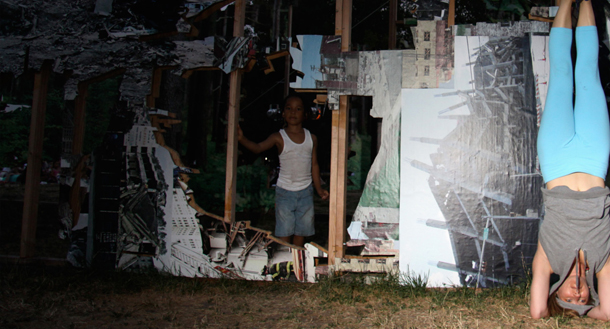
You’ve started working with at-risk teens, can you talk about that a little bit?
It’s one of the hardest things I’ve ever done! It’s really cool, I’m heading into my 5th week there, it’s a handful of girls, they’re not being forced to be there, the dynamic of the campus is that they have all this space, it’s like a college, but they’re in high school and getting psychological treatment. It’s not a lockdown campus, they can leave if they want, but they’ve been sent there either because their foster family couldn’t handle them, or because they were abused…there’s so many reasons. But part of what we offer in what’s called the Therapeutic Arts program is these classes, every Tuesday afternoon they can come and take yoga.
I play songs to get them to move, sometimes they love it, and sometimes they’re like “I don’t want to do this.”
The dynamic of the girls can be very different, one is very quiet and reserved, she doesn’t like the dance part, she just wants to breathe and stretch. And then I have other girls who won’t do it unless the music’s on and they’re moving, moving. And they get into their competitive side, and try to outdo each other. Another girl, her thing is to be as disruptive and out of control with the things she says as possible. Trying to navigate all that can be really intense, but at the same time, I feel like there are moments when I get them, when they connect, even if they stay with me just for a minute, those are really cool moments.
There are ways of threading in this bigger picture stuff, which I think is really important for kids and teens, that can be accessed through this sort of fun, pop culture-ish way to breathe and move.
In situations like this, where you are dealing with young, challenged individuals, some of whom are acting out in a disruptive fashion, what techniques do you employ to get them to redirect their attention to their internal experience?
That’s also going to be a process that I refine over time. It’s not really my job to discipline, I have someone helping me who’s there for that…sometimes if I start losing them I just have to change the subject to get them to come back around to me. With an individual who needs a lot of attention, I try to give it to them in as positive a way as I can, and…I just try to keep it real. Sometimes their reaction is to make fun of me, but sometimes, they get it. It is definitely a navigation right now, and hopefully I if I get to continue to do this, it’s something that I will get better at over time.
Do they have the option of going or not going?
Yeah.
So on some level they want to be there, it’s just that when they’re there, getting them to focus on the program is challenging.
Yep…getting them off their phones, iPods…etc….
That’s really cool that you’re doing that. This is ongoing?
We have another few weeks left, and then there will be a check-in, I’m not sure what happens after that. I agreed to come on for this term.
I think that the Breakti stuff can be intimidating to teenage girls who haven’t been active in a long time, so I have to be conservative about what I give them, but at the same time it gives them a pathway to understanding at least the movement. If they see a dance move that they recognize, then I can at least translate that back to something else in yoga, then it’s like “oh.” Or if I go from yoga and show them how that can translate into a really cool dance move….I think that that, paired with the music, can be really cool with teens.
And my hope is that once I get this really developed for adults, my goal is also to have a teens or kids program developed along the way.
What are the next steps for Breakti?
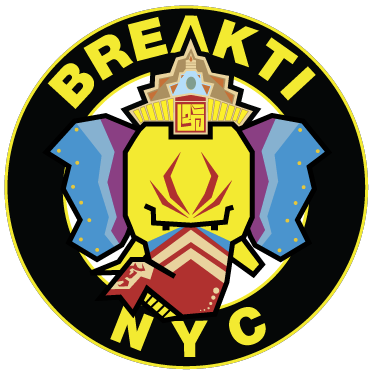 I think working with kids & teens is a huge one, way more powerful even then any Breakti class for adults. It’s going to have to be a totally different thing, but the same mission and concepts behind the class. Creating analogies between movement but also talking about things like Ahimsa, which translates to non-violence. It’s basically the first Yama of yoga. Yamas are basically ways of living your life, and how you treat other people in the world. And the first one is Ahimsa, and I taught them that…it’s not just toward other people but toward yourself. We talked about that a little bit.
I think working with kids & teens is a huge one, way more powerful even then any Breakti class for adults. It’s going to have to be a totally different thing, but the same mission and concepts behind the class. Creating analogies between movement but also talking about things like Ahimsa, which translates to non-violence. It’s basically the first Yama of yoga. Yamas are basically ways of living your life, and how you treat other people in the world. And the first one is Ahimsa, and I taught them that…it’s not just toward other people but toward yourself. We talked about that a little bit.
There are ways of threading in this bigger picture stuff, which I think is really important for kids and teens, that can be accessed through this sort of fun, pop culture-ish way to breathe and move.
Do you have aspirations of having Breakti becoming a larger school, perhaps having different locations around the country?
Yeah. I don’t want to jinx it, but at the moment I’m working with this health club on expanding it to be all over the country, wherever their clubs are. That would be cool, it makes me a little nervous because nobody’s going to walk into teaching a Breakti class after a short training with me and teach it with the exact same understanding and mindset that I have. I have to let that go, but if I will figure out how best to instill that in a short time and will love for it to go all over, wherever people can get something out of it. And if it’s something that can help teens and kids, then I think it’s very much a blessing.
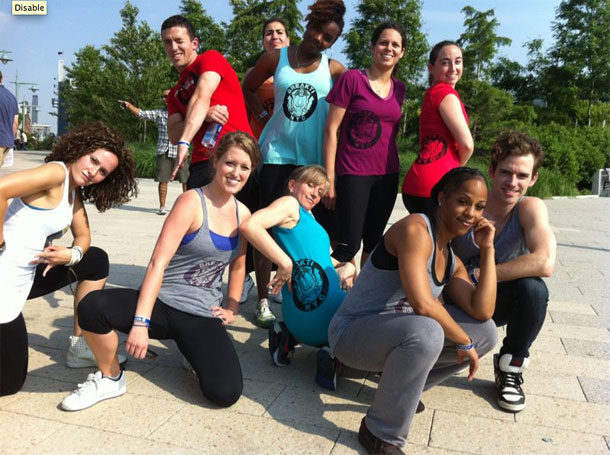
I used to not touch spiritual, or energetic or larger-picture topics. I was so afraid of alienating people. But now I realize that people connect to you better when you’re more authentic about what you are pursuing in your own life.
How long have you been teaching?
I’ve been teaching yoga for 6 years, and I’ve been teaching movement for 11 years.
How has your teaching style changed over the years?
I think that over time I’ve become more & more comfortable with myself. As far as movement goes, I think I have more freedom to teach what I want to teach. I’ve studied a lot of lineages of yoga, and I think they’re all awesome and they all have their place, but I always felt a little constructed by the rules that they all had. That was a conflict for me because I’d think, “Maybe I need to pay attention to this and do it this way because that’s what this group says,” but now I teach a class that is more fully me, and as far as what I talk about aside from the postures, is much more connected to my personal journey.
People sometimes talk about how “New York is losing its soul” and stuff, I feel that maybe in some ways on the surface it is, but underneath all that it’s still there, it’s still buzzing all the time, and I feel like my journey is living proof of that.
Usually when I start a class I talk about something very day-to-day life—something that’s either going on in my life, or going on somewhere in the world or in a friend’s life, something that feels like it could touch people in a way that, say, if I read a Yoga or Buddhist text, it might not. Creating a real-life situation and tying in the theme to that, helps people connect to it. I used to not be comfortable with that at all. I used to not touch spiritual, or energetic or larger-picture topics. I was so afraid of alienating people. But now I realize that people connect to you better when you’re more authentic about what you are pursuing in your own life. In a nutshell, my classes over time reflect more & more who and what I’m about, in a way that I hope that is totally not about me…it’s about them, but I use my own life to connect, and to get them to connect to themselves.

Is there anything else that you wish to discuss?
Only that when you are really honed in to something that you are passionate about, something that you feel in your heart of hearts calls to you, things fall into place.
Ever since I started working with this concept of Breakti things have just fallen into place. Not to sound cheesy, but it’s such an affirmation that the universe provides the means if you have the desire. That is something that I learned in dance and in yoga and in being human, I find it so powerful.
I feel like New York is such a great home for that, there’s so much of that energy here, and I think that’s why people stay here. Even though it’s a really hard place to live sometimes, and people sometimes talk about how “New York is losing its soul” and stuff, I feel that maybe in some ways on the surface it is, but underneath all that it’s still there, it’s still buzzing all the time, and I feel like my journey is living proof of that. So, that’s really cool….
I think it’s really cool too! (laughter)
For more about Anya & Breakti:
Anyaporter.com
A Little Down In Your Dog







